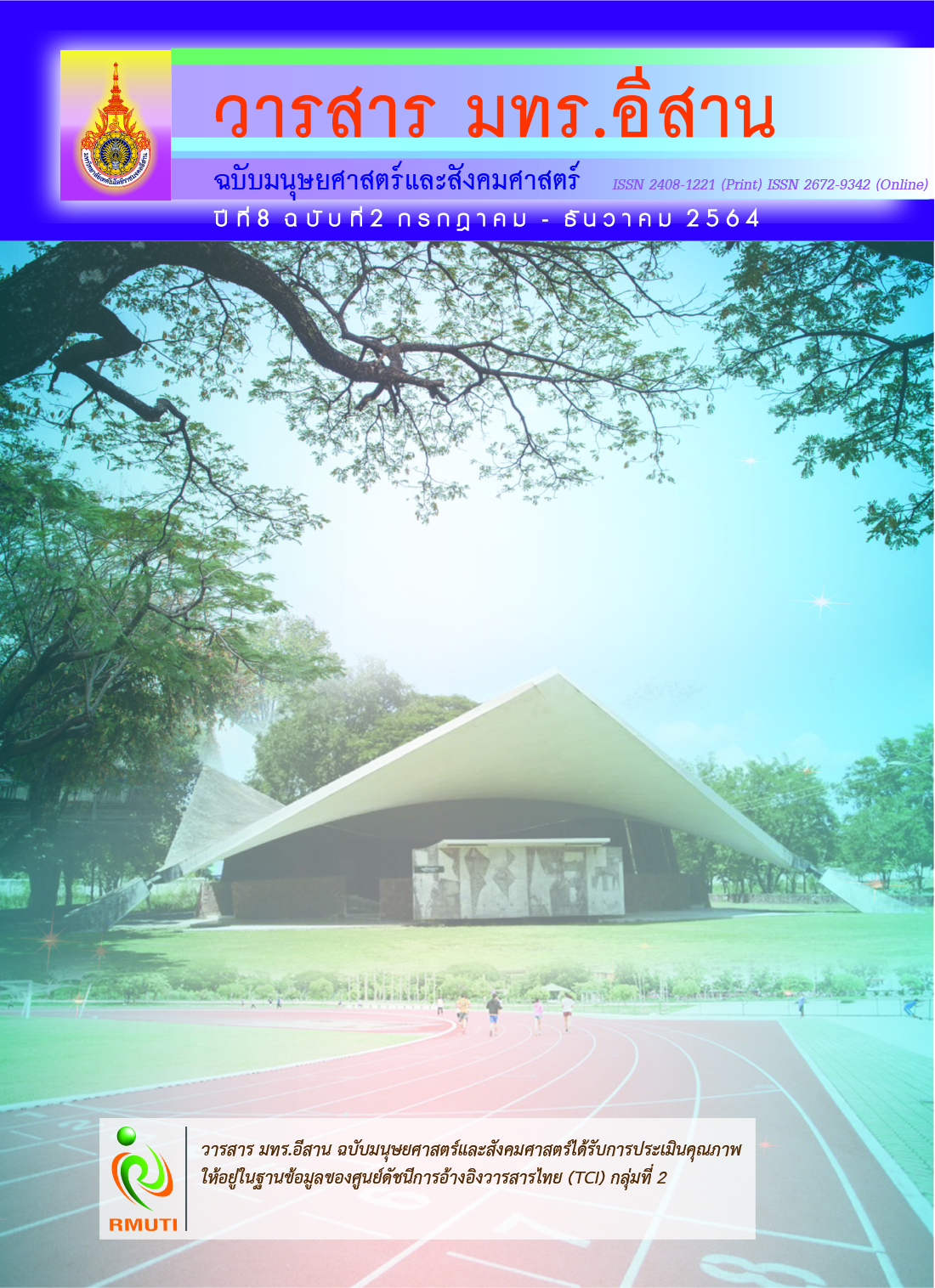Development of Microlearning for Training of Military Officer Training School Directorate of Education and Training
Main Article Content
Abstract
This article presents development of microlearning with the 90/90 standard criterion, compare the military offi cers practical achievement after academic via microlearning and to survey military officers opinions on microlearning for training. The research sample was 50 military Officer Training School Directorate of Education and Training. The instruments used in the study were microlearning, the practical achievement evaluation form, and the questionnaire. The data were analyzed using frequency, percentage, mean, standard deviation, and dependent t-test. The research results revealed that 1) efficiency of the developed microlearning for military officers training is 98.06/98.06 higher than the standard criterion 90/90, 2) the military officers achievement after training via microlearning was statistically significant higher than before training at 0.05 level, and 3) opinion of the military officials training, Military Officer Training School, Directorate of Education and Training, the respondents absolutely agree, representing 86 %, on the procedural process, and agree representing 82 %, facilitating and using microlearning respectively.
Article Details
บทความที่ได้รับการตีพิมพ์เป็นลิขสิทธิ์ของมหาวิทยาลัยเทคโนโลยีราชมงคลอีสาน
ข้อความที่ปรากฏในบทความแต่ละเรื่องในวารสารวิชาการเล่มนี้เป็นความคิดเห็นส่วนตัวของผู้เขียนแต่ละท่านไม่เกี่ยวข้องกับมหาวิทยาลัยเทคโนโลยีราชมงคลอีสานและคณาจารย์ท่านอื่นๆในมหาวิทยาลัยฯ แต่อย่างใด ความรับผิดชอบองค์ประกอบทั้งหมดของบทความแต่ละเรื่องเป็นของผู้เขียนแต่ละท่าน หากมีความผิดพลาดใดๆ ผู้เขียนแต่ละท่านจะรับผิดชอบบทความของตนเองแต่ผู้เดียว
References
จุไรศิริ ชูรัก. (2555). การพัฒนาหลักสูตรฝึกอบรมเรื่อง “หลักสูตรการศึกษาขั้นพื้นฐานของประเทศในกลุ่มประชาคมอาเซียน” สำหรับครูสังกัดมหาวิทยาลัยในจังหวัดสงขลา. วารสารศึกษาศาสตร์ มหาวิทยาลัยทักษิณ. ปีที่ 14, ฉบับที่ 1, หน้า 84-99
ณัฐรินีย์ อภิวงค์งาม. (2554). ศึกษาผลสัมฤทธิ์ทางการเรียนวิทยาศาสตร์และจิตวิทยาศาสตร์ของนักเรียนชั้นมัธยมศึกษาปีที่ 3 ที่ได้รับการจัดการเรียนรู้โดยใช้บริบทเป็นฐานและการจัดการเรียนรู้แบบสืบเสาะหาความรู้. ปริญญานิพนธ์การศึกษามหาบัณฑิต สาขาวิชาการมัธยมศึกษา บัณฑิตวิทยาลัย มหาวิทยาลัยศรีนครินทรวิโรฒ
ณัฐพงษ์ พระลับรักษา. (2562). การพัฒนาสื่อในรูปแบบมุมมอง 360 องศาเพื่อประชาสัมพันธ์มหาวิทยาลัยราชภัฏมหาสารคาม บน Google Street View. มหาสารคาม: มหาวิทยาลัยราชภัฏมหาสารคาม
นพดล ภูมิจันทร์. (2557). ปัญหาระบบการเรียนรู้ที่แพร่หลายเพื่อเพิ่มทักษะการแก้ปัญหาและการรับรู้. กรุงเทพฯ : มหาวิทยาลัยเทคโนโลยีพระจอมเกล้าพระนครเหนือ
พิจิตร ฤทธิ์เจริญ. (2559). การวิจัยทางการศึกษา. กรุงเทพฯ : สำนักพิมพ์จุฬาลงกรณ์มหาวิทยาลัย
ภณัฐญา สุขตลอด. (2561). การเปรียบเทียบผลสัมฤทธิ์ทางการเรียนผ่านไมโครเลิร์นนิ่งระหว่างสมองซีกซ้ายและซีกขวาของนักเรียนชั้นมัธยมศึกษาปีที่ 3. กรุงเทพมหานคร: มหาวิทยาลัยเกษตรศาสตร์
มัทนียา มุสีแก้ว และทัศนสิริน สว่างบุญ. (2563). การสังเคราะห์งานวิจัยเกี่ยวกับการจัดการเรียนการสอน ตามแนวคิดหลักปรัชญาของเศรษฐกิจพอเพียงด้วยการวิเคราะห์อภิมาน. วารสารการวัดผลการศึกษา. ปีที่ 37, ฉบับที่ 101, หน้า 171-185
ศิริภัทร์ รุ่งเรืองสินงาม. (2560). การพัฒนาบทเรียนออนไลน์โดยใช้โปรแกรม EDMODO กลุ่มสาระการเรียนรู้การงานอาชีพและเทคโนโลยีวิชาเทคโนโลยี 3 เรื่อง การสื่อสารข้อมูลและเครือข่ายคอมพิวเตอร์สำหรับนักเรียนชั้นมัธยมศึกษาปีที่ 2. วารสารวิจัยทางการศึกษา คณะศึกษาศาสตร์ มหาวิทยาลัยศรีนครินทรวิโรฒ. ปีที่ 12, ฉบับที่ 1, หน้า 193-204
ศยามน อินสะอาด. (2564). การออกแบบไมโครเลิร์นนิงในยุคดิจิทัล. วารสารเทคโนโลยีและสื่อสารการศึกษา. ปีที่ 16, ฉบับที่ 20, หน้า 16-31
สุริยัน เขตบรรจง และวิลัยวรรณ มาวัน. (2564). เทคโนโลยีปัญญาประดิษฐ์ AI กับการแบ่งกลุ่มข้อมูลผลสัมฤทธิ์ทางการเรียนของนักเรียนชั้นประถมศึกษาปีที่ 5 โดยใช้วิธีการเรียนรู้การแบ่งกลุ่มข้อมูลชนิด K-mean.วารสารครุศาสตร์ จุฬาลงกรณ์มหาวิทยาลัย. ปีที่ 49, ฉบับที่ 2, หน้า 1-11
สรัญญา พันธุ์แก้ว และวรนารถ แสงมณี. (2562). เจตคติที่มีต่อการฝึกอบรมมาตรฐาน ISO/IEC 17025:2005 ของเจ้าหน้าที่ที่ปฏิบัติงานในห้องปฏิบัติการสอบเทียบ. วารสารบริหารและการจัดการ. หน้า 237-252
เอกพงษ์ แก่นจันทร์. (2557). กระบวนการผลิตวีดิทัศน์ (ออนไลน์). เข้าถึงเมื่อ (20 เมษายน 2564). เข้าถึงได้จาก (https://sites.google.com/a/prp.ac.th/khrueak/kar-srang-widithasn)
Bruner, E. (2016). Micro-Learning: What is Microlearning (Online). Access (1 May 2021). Available (www.p4p-solutions.com/?p=65)
Kapp, F., Proske, A., Narciss, S., and Koerndle, H. (2015). Distributing Vs. Blocking Learning Questions In A Web-Based Learning Environment. Journal of Educational Computing Research. Vol. 51, No. 4, pp. 397-416. DOI: 10.2190/EC.51.4.b
Pandey, A. (2016). Benefits Of Microlearning-Based Training (Online). Access (1 May 2021). Available (https://elearningindustry.com/10-benefits-microlearning-based-training)
Russell., F. (2018). 6 Reasons Micro-Learning will make a Huge Impact in Your Organization. the Founder and CEO of Prosition. May 1, 2021
Tim, B. (2017). 10 Lessons For Creating Effective Microlearning (Online). Access (1 May 2021). Available (https://www.hr.com/en/leadership_excellence_essentials)


